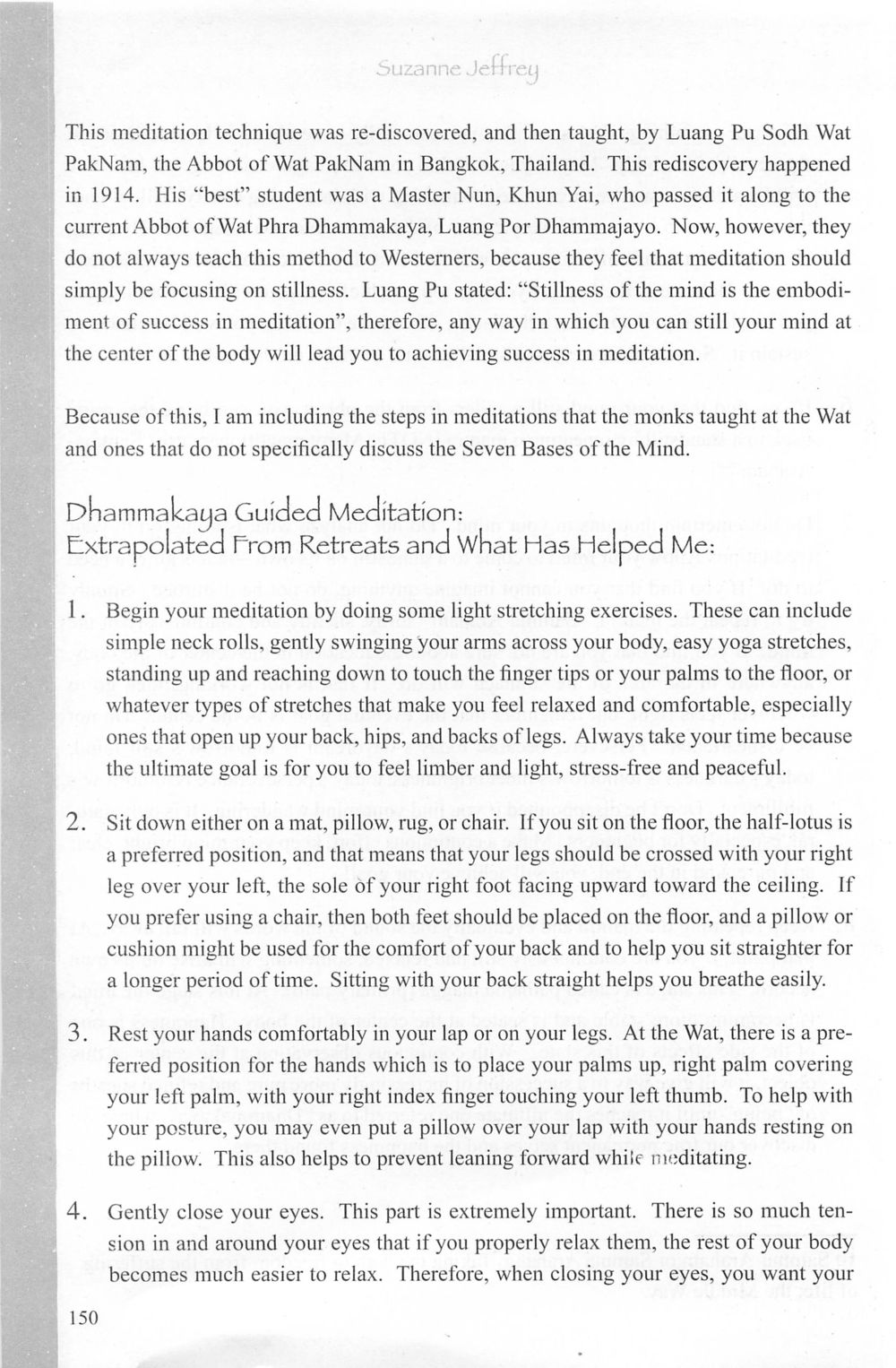Meditation Techniques From Wat PakNam : หน้า 149/164
The Meeting with a Dhamma Master : หน้า 149/164 Learn meditation techniques rediscovered by Luang Pu Sodh at Wat PakNam, focusing on achieving stillness of the mind.
0 ครั้ง

สรุปเนื้อหา
This text explores meditation techniques rediscovered by Luang Pu Sodh at Wat PakNam in 1914. His teachings emphasize stillness of the mind as key to meditation success. Detailed steps include stretching exercises, proper sitting postures, and hand positioning for effective meditation. The practice encourages relaxation and the achievement of a stress-free state. Follow these methods to enhance your meditation journey while learning from the teachings of leading monks.
หัวข้อประเด็น
-Meditation Techniques
-History of Wat PakNam
-Role of Luang Pu Sodh
-Dhammakaya Meditation
-Stillness of the Mind
ข้อความต้นฉบับในหน้า
Suzanne Jeffrey
This meditation technique was re-discovered, and then taught, by Luang Pu Sodh Wat PakNam, the Abbot of Wat PakNam in Bangkok, Thailand. This rediscovery happened in 1914. His “best” student was a Master Nun, Khun Yai, who passed it along to the current Abbot of Wat Phra Dhammakaya, Luang Por Dhammajayo. Now, however, they do not always teach this method to Westerners, because they feel that meditation should simply be focusing on stillness. Luang Pu stated: “Stillness of the mind is the embodiment of success in meditation”, therefore, any way in which you can still your mind at the center of the body will lead you to achieving success in meditation.
Because of this, I am including the steps in meditations that the monks taught at the Wat and ones that do not specifically discuss the Seven Bases of the Mind.
Dhammakaya Guided Meditation:
Extrapolated From Retreats and What Has Helped Me:
1. Begin your meditation by doing some light stretching exercises. These can include simple neck rolls, gently swinging your arms across your body, easy yoga stretches, standing up and reaching down to touch the finger tips or your palms to the floor, or whatever types of stretches that make you feel relaxed and comfortable, especially ones that open up your back, hips, and backs of legs. Always take your time because the ultimate goal is for you to feel limber and light, stress-free and peaceful.
2. Sit down either on a mat, pillow, rug, or chair. If you sit on the floor, the half-lotus is a preferred position, and that means that your legs should be crossed with your right leg over your left, the sole of your right foot facing upward toward the ceiling. If you prefer using a chair, then both feet should be placed on the floor, and a pillow or cushion might be used for the comfort of your back and to help you sit straighter for a longer period of time. Sitting with your back straight helps you breathe easily.
3. Rest your hands comfortably in your lap or on your legs. At the Wat, there is a preferred position for the hands which is to place your palms up, right palm covering your left palm, with your right index finger touching your left thumb. To help with your posture, you may even put a pillow over your lap with your hands resting on the pillow. This also helps to prevent leaning forward while meditating.
4. Gently close your eyes. This part is extremely important. There is so much tension in and around your eyes that if you properly relax them, the rest of your body becomes much easier to relax. Therefore, when closing your eyes, you want your
150
หน้าหนังสือทั้งหมด

1

2

3

4

5

6

7

8

9

10

11

12

13

14

15

16

17

18

19

20

21

22

23

24

25

26

27

28

29

30

31

32

33

34

35

36

37

38

39

40

41

42

43

44

45

46

47

48

49

50

51

52

53

54

55

56

57

58

59

60

61

62

63

64

65

66

67

68

69

70

71

72

73

74

75

76

77

78

79

80

81

82

83

84

85

86

87

88

89

90

91

92

93

94

95

96

97

98

99

100

101

102

103

104

105

106

107

108

109

110

111

112

113

114

115

116

117

118

119

120

121

122

123

124

125

126

127

128

129

130

131

132

133

134

135

136

137

138

139

140

141

142

143

144

145

146

147

148

149

150

151

152

153

154

155

156

157

158

159

160

161

162

163

164
หนังสือที่เกี่ยวข้อง
Load More
